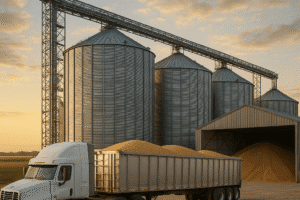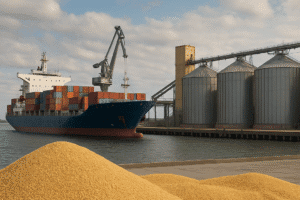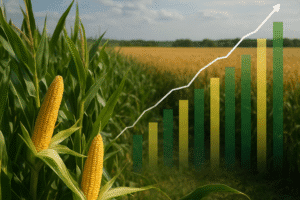The 2025 harvest season has delivered one of the most dynamic outcomes in recent memory for the global grain markets. Record swings in weather patterns collided with technological breakthroughs and shifting demand dynamics to create a landscape of both unprecedented opportunity and acute risk. Farmers, traders, policy makers, and supply chain participants around the world found themselves responding to evolving conditions at every stage of the journey from field to fork. This analysis explores the pivotal forces that shaped the 2025 season, identifies the key winners and losers, and examines the long-term implications for the global grain trade.
Global Harvest Overview
Across six continents, total cereal production soared to nearly 2.9 billion tonnes, driven largely by strong maize and wheat outputs. However, this headline number masks dramatic regional contrasts. La Niña conditions in early spring brought unseasonal dry spells to parts of North America, even as southern Africa benefited from well-timed rainfall. In Europe, mild temperatures and extended sunlight boosted spring barley yields, while late-season storms in Eastern Europe damaged portions of the sunflower seed crop. The interplay of weather extremes underscored the deepening influence of climate volatility on agricultural cycles.
Technological adoption reached new heights: satellite-driven analytics and precision irrigation systems spread steadily across major producing regions. Many large-scale operations used advanced AI models to fine-tune fertilizer application, improving nitrogen-use efficiency and pushing up average per-hectare yield by 4 percent in benchmark farms. Yet inequality in technology access left several smallholder communities struggling to keep pace, fuelling outright yield gaps of 20 to 30 percent compared to well-equipped counterparts.
Key Winners in the 2025 Harvest
North American Exporters
- United States maize growers secured bumper crops in the Midwest, capitalizing on upgraded seed genetics to increase drought resilience. Strong domestic harvests allowed traders to lock in export contracts for 45 million tonnes, up 8 percent year-over-year.
- Canada’s Prairie provinces enjoyed robust spring wheat performance. Elevated global demand for high-protein milling wheat drove premiums on Gulf Coast contracts, lifting producer incomes by over 12 percent.
South American Surge
- Brazil’s second-crop safrinha maize boomed thanks to abundant rainfall and expanded planting area. At nearly 130 million tonnes, this harvest established Brazil as the world’s top maize supplier for the first time.
- Argentina’s soybean sector rebounded from fiscal uncertainties as exporters moved decisively to clear backlogs. Increased logistical capacity at river ports improved turnaround times and opened new markets in Southeast Asia.
Agribusiness Leaders and Input Suppliers
- Major input manufacturers reported strong sales of precision technology packages and balanced fertilizer blends, highlighting growing farmer appetite for yield-enhancing innovations.
- Grain trading houses that integrated real-time weather data and logistics networks successfully navigated bottlenecks, capturing unusually high margins amid shifting export routes.
Major Losers and Their Challenges
Drought-Stricken Regions
- Australia’s winter cereal belt endured its driest planting season in a decade. Wheat production fell 18 percent below the five-year average, forcing heavy reliance on imports to satisfy domestic consumption.
- Parts of the US southern plains witnessed severe drought throughout summer, curtailing both maize and sorghum outputs. Local basis levels widened sharply, reflecting acute supply stress.
Smallholder Constraints in Developing Economies
- In East Africa, erratic rainfall patterns and limited access to quality seed dampened maize yields, compounding food security concerns and driving up local prices by over 30 percent.
- South Asia’s minor millet producers faced soaring fertilizer costs amid import tariff increases. Many small farms cut back on fertilization rates, leading to a drop in both yield and grain quality.
Commodity Price Volatility
While average grain prices ended the season modestly lower due to ample global stocks, intra-season swings triggered margin calls among leveraged traders and provoked hedging losses for risk-averse stakeholders. The rebound in late-year futures contracts failed to offset early slump, highlighting persistent price volatility risks in the marketplace.
Market Implications and Future Outlook
Record production in key exporting regions has reinforced the narrative of abundant global supplies, yet pockets of underperformance underscore ongoing sustainability concerns. Elevated stock-to-use ratios should encourage consumers to restock and defer purchases in the first half of 2026, likely keeping a ceiling on futures prices. Meanwhile, infrastructure bottlenecks and geopolitical tensions in maritime chokepoints may sustain premium freight spreads.
Investors are closely monitoring policy signals, particularly regarding export restrictions and domestic support measures. A recent uptick in import duties in some Southeast Asian markets suggests governments remain sensitive to local price pressures. For forward-looking participants, opportunities lie in funding resilience-building projects such as irrigation upgrades, post-harvest storage expansion, and digital advisory services for smallholders.
The interplay between technology-driven productivity gains and mounting climate stress will shape the next decade of grain production. Stakeholders capable of bridging the divide between financing, innovation, and inclusive outreach stand to secure the greatest long-term rewards—even as unpredictable weather events continue to produce both winners and losers on an annual basis.













